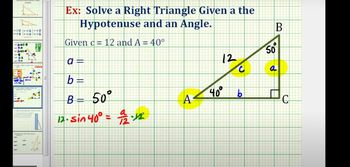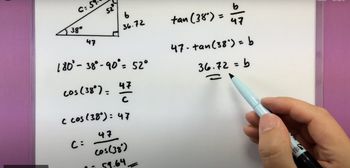Table of contents
- 0. Review of College Algebra4h 43m
- 1. Measuring Angles39m
- 2. Trigonometric Functions on Right Triangles2h 5m
- 3. Unit Circle1h 19m
- 4. Graphing Trigonometric Functions1h 19m
- 5. Inverse Trigonometric Functions and Basic Trigonometric Equations1h 41m
- 6. Trigonometric Identities and More Equations2h 34m
- 7. Non-Right Triangles1h 38m
- 8. Vectors2h 25m
- 9. Polar Equations2h 5m
- 10. Parametric Equations1h 6m
- 11. Graphing Complex Numbers1h 7m
2. Trigonometric Functions on Right Triangles
Solving Right Triangles
Problem 31
Textbook Question
Textbook QuestionIn Exercises 29–36, find the length x to the nearest whole unit.

 Verified Solution
Verified SolutionThis video solution was recommended by our tutors as helpful for the problem above
Video duration:
4mPlay a video:
Was this helpful?
Key Concepts
Here are the essential concepts you must grasp in order to answer the question correctly.
Right Triangle Properties
A right triangle has one angle measuring 90 degrees, and the relationships between the angles and sides are governed by trigonometric ratios. In this problem, the right triangle's height (x) and base (1600) can be analyzed using these properties to find unknown lengths based on known angles.
Recommended video:

30-60-90 Triangles
Trigonometric Ratios
Trigonometric ratios, such as sine, cosine, and tangent, relate the angles of a triangle to the lengths of its sides. For example, in this triangle, the tangent of the angle can be used to express the height (x) in terms of the base (1600) and the angle (66°), allowing for the calculation of x.
Recommended video:

Introduction to Trigonometric Functions
Angle Relationships in Triangles
The sum of the angles in any triangle is always 180 degrees. In this case, knowing one angle (66°) allows us to find the other angle (24°) since the right angle is 90°. This relationship is crucial for applying trigonometric functions correctly to solve for the unknown side length.
Recommended video:

30-60-90 Triangles

 4:18m
4:18mWatch next
Master Finding Missing Side Lengths with a bite sized video explanation from Nick Kaneko
Start learningRelated Videos
Related Practice














